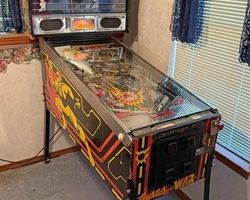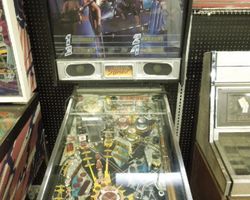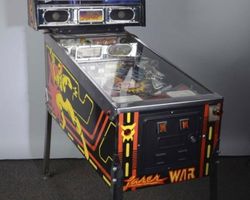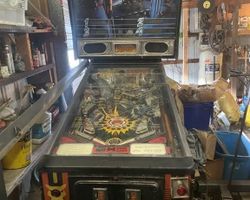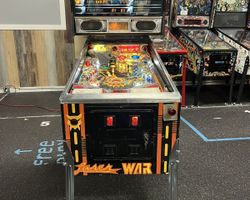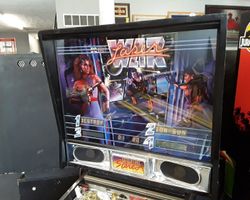Laser War
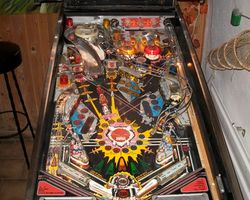
Average Prices: USD $200 to $1,300
Produced: 2016
Production Run: 2,569 units
Players: 4
Design by: Joe Kaminkow
Art by: Kevin OConnor, Margaret Hudson, Kevin O'Connor
Music by: David Thiel
Sound by: David Thiel
Software by: Lonnie D. Ropp, Richard Ditton
Laser War by Data East holds a unique place in pinball history, not only as the inaugural machine from Data East USA, Inc. but also for pioneering a significant technological advancement in arcade sound. Released in March 1987, with production running from May 1987 to February 1988, this solid-state electronic machine marked the entry of a new manufacturer into a competitive market. The creation of Laser War was remarkably swift, designed by Joe Kaminkow and Gary Stern on Thanksgiving Day in 1986. They utilized parts from Williams' 1986 release, Road Kings, to expedite the process, highlighting an adaptive approach to early machine development. A total of 2,569 units of the Laser War pinball machine were produced, establishing Data East's initial footprint in the pinball industry.
Adding to its historical distinctiveness, Laser War was the first pinball machine from any manufacturer to feature a stereo 2.1 channel sound system, incorporating stereo sound plus a subwoofer. This audio innovation, with music and sound designed by David Thiel, brought a new level of immersion to the gameplay experience. Early production models of Laser War also included a specialized backbox topper – a Lyte Sound Visualizer manufactured by Clyde Industries America Inc., housed in a custom trapezoidal enclosure. This topper was designed to react visually to the game's sounds, creating a dynamic optical effect. However, due to its cost, this visually striking feature was discontinued during the production run, with an estimated 500 units featuring it. The machine’s theme, a blend of sci-fi, space, and fantasy, captured the essence of 1980s laser tag culture, shaping its distinct aesthetic. Software development was handled by Lonnie D. Ropp and Richard Ditton, while Kevin O'Connor and Margaret Hudson contributed to the artwork.
Signature Features and Design
The Laser War pinball machine stands out with several key features that contribute to its identity and gameplay. Foremost among these is its revolutionary stereo 2.1 channel sound system. This audio setup, a first for the industry, provided a richer, more dynamic soundscape than previous mono or basic stereo systems, enhancing the digital music and custom speech call-outs from David Thiel. This sonic innovation became a hallmark of Data East pinball machines, setting a new standard for audio fidelity.
Visually, the machine is defined by its strong 1980s sci-fi aesthetic, characterized by a vibrant but often debated art package. The playfield features an interactive toy in the form of a laser-gun turret positioned above the main ramp. While primarily a visual element, this turret includes an internal light show that integrates with gameplay, particularly during jackpot sequences, adding to the game's spectacle. Other notable mechanical features include two spinning targets, three kick-out holes, three pop bumpers, and a left outlane kickback mechanism designed to save a drained ball and return it to play, offering players a second chance. The alphanumeric display for the first and second players provides clear scoring and game information. The presence of both 2-ball and 3-ball multiball modes, along with a lane-change feature for the upper playfield lanes, further adds to the strategic depth and excitement of the gameplay.
Playfield and Mechanics
The playfield of the Laser War pinball machine is laid out with an emphasis on fast-paced action and engaging shots. Central to the layout is a prominent single ramp, strategically placed to offer a satisfying shot that leads directly back to the right flipper. This design choice is critical to the game's flow, as it allows for repeated ramp shots without interrupting the rhythm of play, encouraging continuous action rather than dead-end returns. This direct return to the flipper, as opposed to an outlane or upper playfield, creates a smooth, re-entrant loop that is highly rewarding to execute.
Below the main ramp, three pop bumpers are positioned to create a lively and unpredictable environment, propelling the ball around the upper playfield and into various targets. The playfield also incorporates three kick-out holes, often referred to as "bases," which serve as ball lock mechanisms for initiating multiball. Two spinning targets are integrated into the shot map, providing valuable points and a kinetic element as the ball passes through them. The two main flippers control the lower playfield, while the left outlane is protected by a kickback, offering a crucial save during intense gameplay.
The artwork on the playfield, while sometimes considered sparse compared to later, more detailed designs, adheres to the overarching sci-fi and laser tag theme. It features dynamic illustrations of futuristic landscapes and battles. The lighting design for Laser War is particularly effective, especially for its era. The game features impressive light shows, most notably during jackpot sequences, which flash in synchronization with the game's stereo sound, creating a visually and audibly compelling experience. The overall aesthetic is distinctly 80s, embracing a colorful, somewhat campy, but ultimately charming style that complements the machine's energetic gameplay.
Gameplay Dynamics
The gameplay dynamics of Laser War are straightforward yet engaging, centered around a clear progression towards multiball and jackpot scoring. The primary objective involves hitting a series of targets located throughout the playfield. Successfully hitting these targets lights the "bases," which are the three kick-out holes. Once a base is lit, shooting the ball into it locks it in place. The game progresses through two distinct multiball phases: initially a 2-ball multiball, followed by a more challenging 3-ball multiball. Players must lock the requisite number of balls within a specific timeframe to activate these modes.
Once multiball is active, the game's main scoring opportunity, the "Ion Cannon" jackpot, becomes available. This high-value shot is achieved by successfully shooting the ball up the central ramp, often while juggling multiple balls. The ramp shot is the most prominent and rewarding shot on the playfield, becoming the focus during multiball for significant point accumulation. The challenge lies in maintaining control of multiple balls while accurately hitting the ramp, making for an intense and exciting experience.
While the ruleset is considered relatively simple, some players find the game's flow and the satisfaction of hitting the ramp shot to be highly addictive. The fast-paced action, combined with the groundbreaking stereo sound and light shows during jackpots, creates moments of genuine excitement. The game lacks a dedicated skill shot on the initial plunge, meaning players immediately dive into active play. Players often develop strategies focused on consistently hitting targets to light locks and then mastering the ramp shot during multiball. Despite its perceived simplicity by some, the game's energetic rhythm and the thrill of securing multiball and jackpots offer a compelling experience that encourages repeated plays.
Reception and Legacy
Upon its release, the Laser War pinball machine received a varied but generally positive reception within the pinball community, a noteworthy achievement for a manufacturer's first endeavor. A significant strength frequently highlighted is its distinct 1980s theme, which, despite its "cheesy" aesthetic for some, evokes a strong sense of nostalgia for many players. This embrace of its era's visual style, particularly the vibrant color palette, contributes to its enduring appeal.
The sound system of Laser War is consistently praised. As the first pinball machine to feature a stereo 2.1 channel sound system, it delivered an immersive audio experience that was unparalleled at the time. Reviewers often point to the impressive light shows, particularly during jackpot sequences, as a major highlight, noting how the synchronized visuals and sound create exciting and rewarding moments. Gameplay is frequently described as fast, fun, and energetic, with the direct return of the ramp shot to the right flipper cited as a key contributor to its satisfying flow. The progression to and execution of multiball is also well-received, adding a layer of excitement and challenge. For many, Laser War is considered an excellent value and a solid entry point into pinball collecting. Its addictive quality is often mentioned, with players experiencing the urge for "just one more game."
However, the machine also has its detractors. The artwork, particularly on the translite (backglass), is a common point of contention, frequently described as "terrible" or "ugly" by some, though others embrace its kitschy charm. The ruleset is sometimes criticized for its simplicity and a perceived lack of depth, which can lead to repetitive gameplay for advanced players seeking complex objectives. Some players also note the potential for frequent center drains, necessitating strong nudging skills to mitigate "ruthless" ball drains. While the sound is generally lauded, a few reviewers found the voice call-outs to be repetitive compared to later Data East titles.
Despite these criticisms, Laser War holds a significant place in pinball history. It is recognized as Data East's foundational pinball machine, establishing the company as a formidable player in the industry. Its pioneering stereo 2.1 channel sound system set a new technical benchmark for future pinball machines, influencing subsequent designs across the industry. For many, it remains a "hidden gem" – an enjoyable, accessible, and historically important pinball machine that continues to be appreciated for its unique blend of 80s charm, innovative sound, and engaging, fast-paced play.
Sponsored Links
 Ebay Listings
Ebay Listings
 Auction Results
Auction Results
| Cost | Location | Date |
|---|---|---|
| USD $751 |  Kansas, United States Kansas, United States |
12 June, 2025 |
| USD $2,889 |  Florida, United States Florida, United States |
11 March, 2024 |
| USD $4,395 |  Ohio, United States Ohio, United States |
03 November, 2022 |
| USD $950 |  Pennsylvania, United States Pennsylvania, United States |
28 December, 2021 |
| EUR €1,230 |  Nordrhein-Westfalen, Germany Nordrhein-Westfalen, Germany |
23 October, 2021 |
| USD $2,100 |  Illinois, United States Illinois, United States |
09 July, 2020 |
| USD $3,499 |  California, United States California, United States |
17 June, 2019 |
| EUR €828 |  Thüringen, Germany Thüringen, Germany |
10 February, 2019 |
| EUR €1,166 |  Baden-Württemberg, Germany Baden-Württemberg, Germany |
16 December, 2018 |
| AUD $2,225 |  Queensland, Australia Queensland, Australia |
30 November, 2018 |


Private Policy · Search Website · Contact Us
As an eBay Partner, we may earn a commission from qualifying purchases made through links on this site, at no additional cost to you.
All trademarks and copyrighted materials remain property of their respective owners. All other content copyright 2007 - 2025 Pinpedia.

